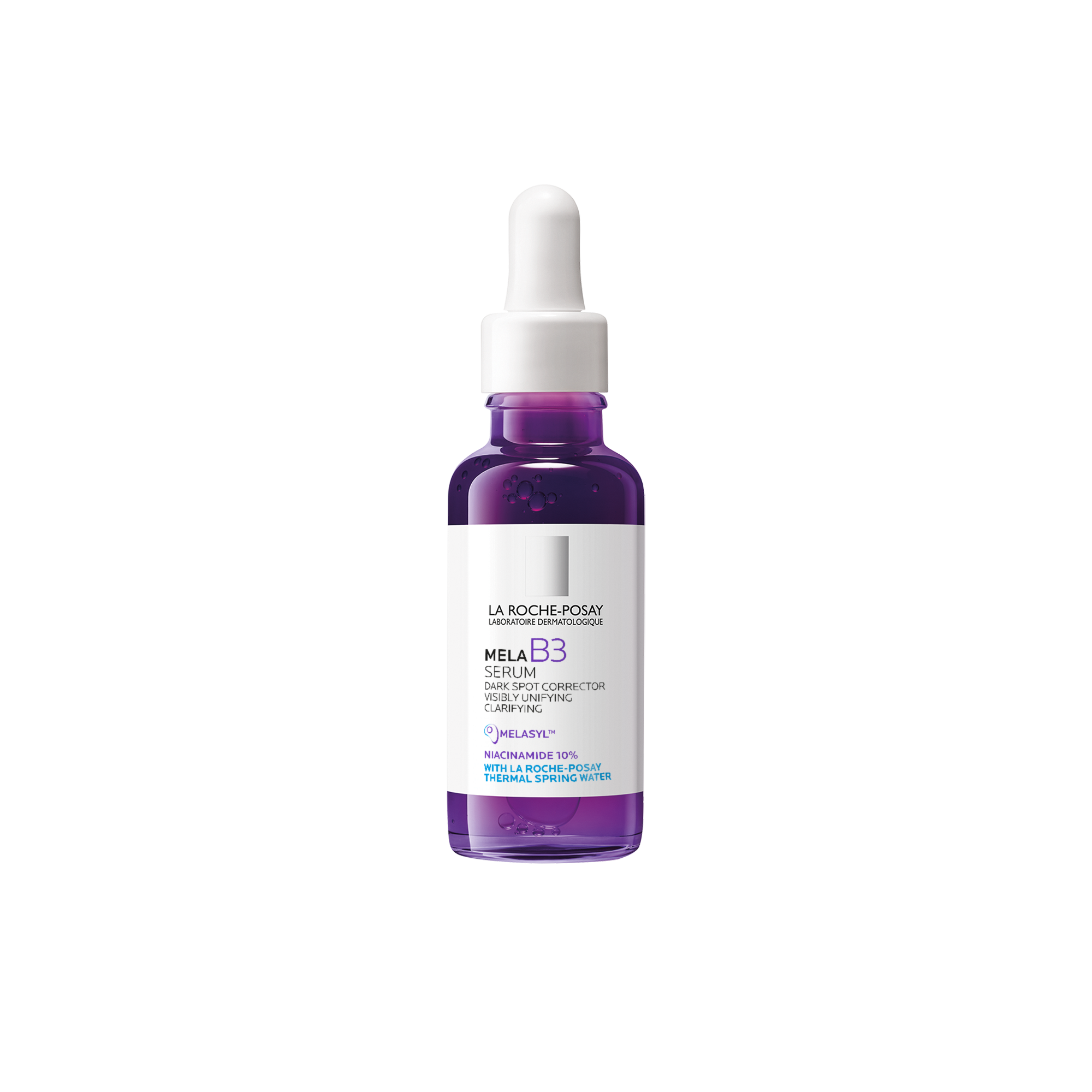- Acne
- Actinic Keratosis
- Aesthetics
- Alopecia
- Atopic Dermatitis
- Buy-and-Bill
- COVID-19
- Case-Based Roundtable
- Chronic Hand Eczema
- Chronic Spontaneous Urticaria
- Drug Watch
- Eczema
- General Dermatology
- Hidradenitis Suppurativa
- Melasma
- NP and PA
- Pediatric Dermatology
- Pigmentary Disorders
- Practice Management
- Precision Medicine and Biologics
- Prurigo Nodularis
- Psoriasis
- Psoriatic Arthritis
- Rare Disease
- Rosacea
- Skin Cancer
- Vitiligo
- Wound Care
Feature
Article
Dermatology Times
La Roche-Posay Unveils New Molecule in Mela B3 Serum to Target Discoloration
Author(s):
Data on pigmentary disorders worldwide and clinical study results were presented at the IMCAS World Congress 2024 meeting.
Photo courtesy of La Roche-Posay

La Roche-Posay recently launched Mela B3, a serum targeting persistent discoloration using 10% niacinamide, La Roche-Posay Thermal Spring Water, and La Roche-Posay’s newest proprietary molecule, Melasyl. Melasyl is based on 18 years of research and sets Mela B3 apart as a new OTC product to treat dark spots and post-acne marks in all skin types.
Data from clinical studies on the efficacy of Mela B3 as well as one of the largest worldwide surveys on the most common pigmentary disorders were presented at the International Master Course on Aging Science (IMCAS) World Congress 2024 meeting in Paris, France.
Exploring Global Epidemiology of Pigmentation Disorders
Delphine Kerob, MD, MSc, a board-certified dermatologist from France and the scientific director of La Roche-Posay, a L’Oréal-owned brand, began the lecture at IMCAS by discussing the International Survey on Pigmentation-Disorders Observational Tracking (I’SPOT), a survey evaluating the epidemiology, impact on quality of life, and social stigmatization of the 6 most common pigmentary disorders worldwide.1
“We conducted this I’SPOT study because we didn’t find in the literature any reference to understanding the worldwide prevalence of different pigmentary disorders. We know that there are some studies available about melasma, postinflammatory hyperpigmentation, and solar lentigos in some local countries, but there was no 1 study describing the worldwide prevalence as well as the impact on quality of life and social stigmatization,” said Kerob.
The I’SPOT survey included 48,000 participants, represented 34 countries, and was conducted from December 2022 to February 2023. Clinical results demonstrated that 50% of people worldwide are affected by some type of pigmentary disorder. The participants’ conditions were as follows:
- 27% (n=13201) of participants had solar lentigo
- 18% (n=8289) of participants had axillary hyperpigmentation
- 15% (n=7126) of participants had periorbital hyperpigmentation
- 15% (n=7076) of participants had postinflammatory hyperpigmentation
- 11% (n=5237) of participants had melasma
- 8% (n=3394) of participants had vitiligo
The 6 measured pigmentary disorders were most prevalent among women, postinflammatory hyperpigmentation and vitiligo were most prevalent in participants younger than 30 years, and solar lentigo was most prevalent in participants 50 years and older.
“We observed that there was also a higher prevalence of pigmentary disorders, except for solar lentigo, in patients with darker skin types from Fitzpatrick skin types IV to VI, except for melasma as well, which was very well balanced between the 2 populations of Fitzpatrick I to III and IV to VI,” said Kerob.
Next, Kerob reviewed the Dermatology Life Quality Index (DLQI) scoring from the study, which ranged from 0 to 30 points calculated from answers to 10 questions. For a score of 11 to 30 and having a “very or extremely large effect on patient’s life,”
- 34% of participants with melasma agreed
- 35% of participants with postinflammatory hyperpigmentation agreed
- 15% of participants with solar lentigo agreed
- 47% of participants with vitiligo agreed
- 30% of participants with periorbital hyperpigmentation agreed
- 33% of participants with axillary hyperpigmentation agreed
Overall, 28% of all participants had a DLQI score above 10 points.
Regarding stigmatization with pigmentary disorders, 51% of participants with melasma, 57% of participants with postinflammatory hyperpigmentation, and 30% of participants with solar lentigo believed it was better to conceal or hide the visible parts of their affected skin. Additionally, 24% of participants with melasma, 25% of participants with postinflammatory hyperpigmentation, and 12% of participants with solar lentigo have felt that they have been less loved by their friends or family due to their appearance.
Mela B3: Tackling Melanin Precursors
Seventyfour/AdobeStock

La Roche-Posay’s Mela B3 serum contains a novel molecule researched by the La Roche-Posay team, 2-mercaptonicotinoyl glycine (2-MNG). 2-MNG, named Melasyl, inhibits melanin synthesis and UV-induced immediate pigmentation through a new mode of action tackling precursors of melanin.2
Peggy Sexitus, the head of L’Oréal’s Research and Innovation Laboratory, presented the new research on 2-MNG and its benefits in treating discoloration.
“For the discovery of this new molecule, we set up a high throughput screening test that was loaded to screen over 100,000 raw materials blindly for the capacity to inhibit melanin synthesis. We wanted the innovation to have a blind screening and to screen a lot of molecules. It is through this high throughput that led us to discover the thiopyridone chemical family, which has been very new but also very potent to inhibit melanin synthesis,” explained Sexitus.
The La Roche-Posay research team used digital tools to optimize the molecule to improve its safety, environmental respect, and skin penetration properties. Sexitussaidthat through the process of in vitro screenings and digital design, researchers discovered 2-MNG.
In their research, Sexitus’ team confirmed that 2-MNG has no impact on melanocyte viability. Additionally, the team confirmed the efficacy of 2-MNG through the topical application on ex vivo human skin models.
Sexitussaid her team also investigated the mechanism of action of 2-MNG and found that it does not inhibit tyrosine as other products may. Through researching 2-MNG’s unique mechanism of action, the researchers found that 2-MNG binds and inactivates melanin precursors, including L-DOPA, DHICA, and DHI, therefore preventing them from becoming involved in pigment production.
Kerob returned to the stage to conclude the Mela B3 discussion by reviewing its key ingredients and recent clinical success photos. For optimal skin health while treating discoloration, Mela B3 contains hyaluronic acid, glycerin, Melasyl, lipohydroxy acid, retinyl palmitate, carnosine, niacinamide, K2G, and cystoseira tamariscifolia extract.3
Kerob reviewed a 3-month study that included adult patients with post-acne postinflammatory hyperpigmentation in Fitzpatrick skin types III to VI who applied Mela B3 serum in the morning and evening. Specific sunscreen was not provided to the patients so that the researchers could see the real effect of the serum.
A significant decrease in the contrast between spots and adjacent skin was observed at 56 days and continued to improve over 3 months. Additionally, spot visibility was reduced by 60% by day 84.
“We saw that there is a high prevalence of pigmentary disorders with a strong impact on quality of life and social stigmatization. We also had this nice presentation from Peggy showing this new molecule, which leads to an innovative product to manage hyperpigmentation disorders centered around Melasyl. It has a nice efficacy in patients with postinflammatory hyperpigmentation and follow us because there is more to come very soon,” concluded Kerob.
References
- Kerob D. Pigmentary disorders worldwide survey: epidemiology, impact on quality of life and stigmatization. Presented at: IMCAS World Congress 2024; February 1, 2024; Paris, France.
- Sexitus P. New ingredient to decrease melanin. Presented at: IMCAS World Congress 2024; February 1, 2024; Paris, France.
- Kerob D. Hyperpigmentation: clinical results with the latest La Roche-Posay innovation. Presented at: IMCAS World Congress 2024; February 1, 2024; Paris France.

Newsletter
Like what you’re reading? Subscribe to Dermatology Times for weekly updates on therapies, innovations, and real-world practice tips.




























